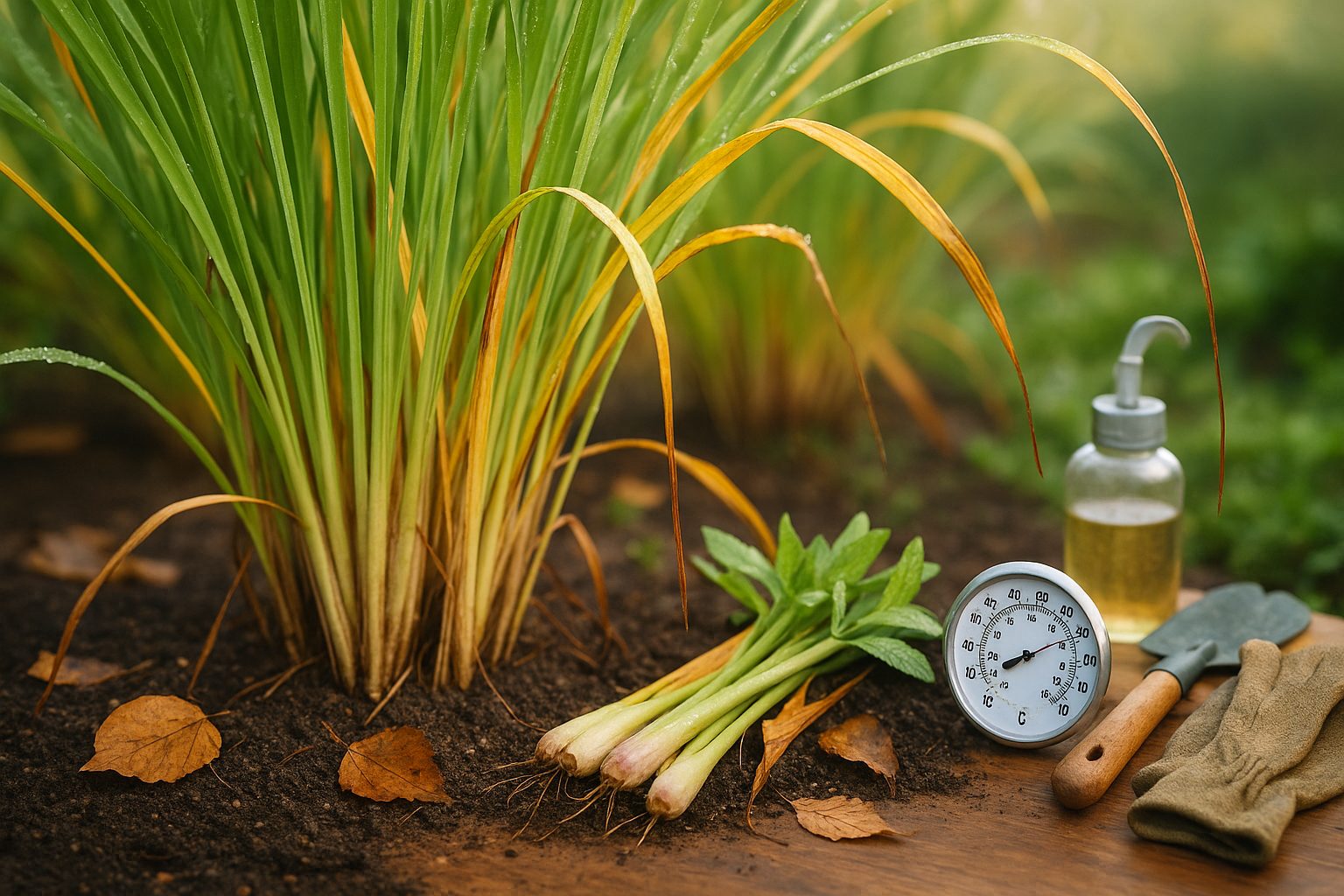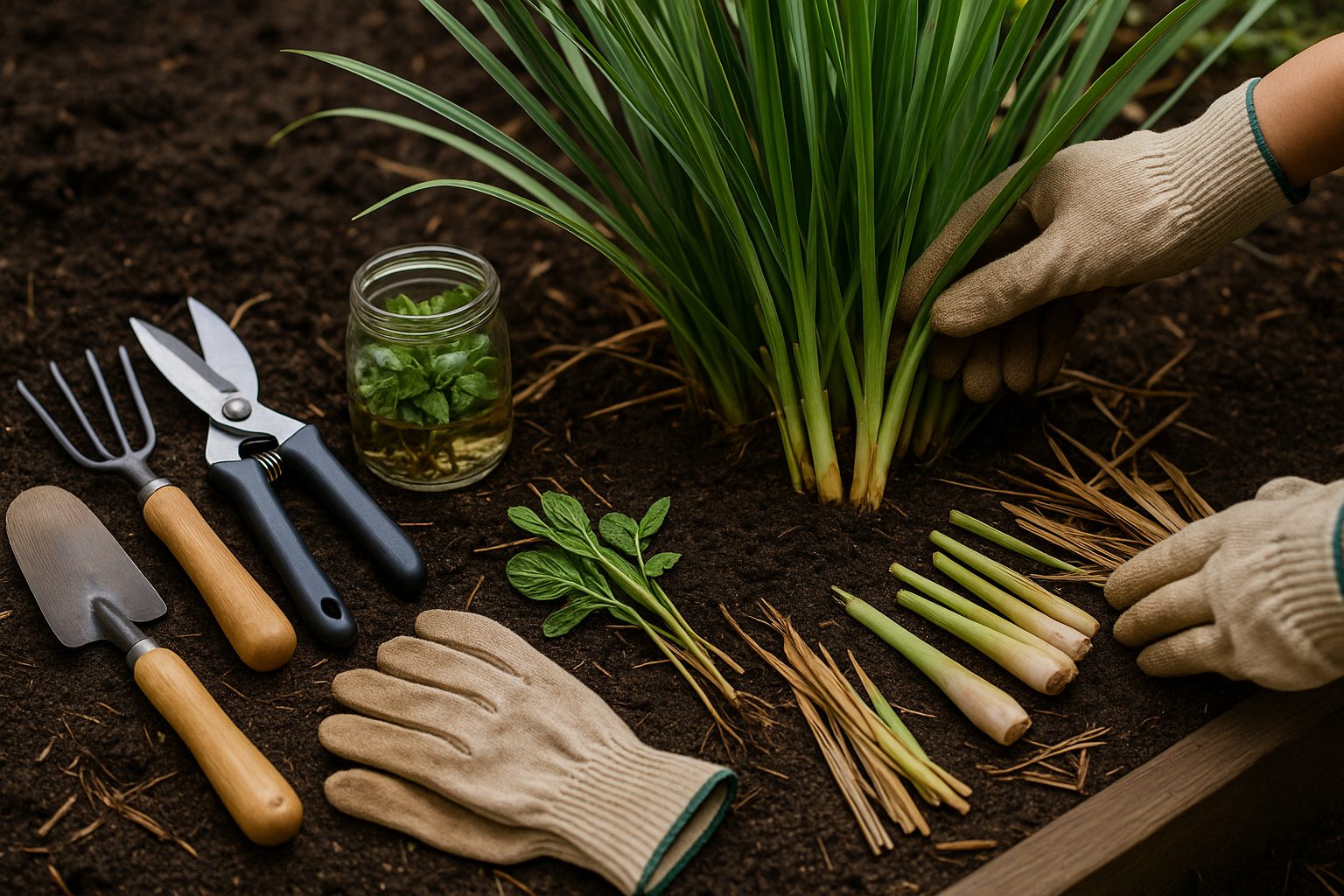Understanding Lemongrass Growth & Dormancy

Pruning lemongrass is essential for keeping your plants healthy and productive, but knowing when to trim is just as important as knowing how. Lemongrass follows a distinct growth cycle that changes with the seasons—understanding this helps you time your maintenance for the best results.
During the warmer months, lemongrass grows rapidly, sending up clusters of bright green stems and leafy blades, perfect for harvest and use in your favorite recipes or homemade teas. As temperatures begin to cool in late fall or early winter, the plant starts preparing for a period of dormancy. This is when growth slows or stops entirely, allowing the plant to conserve energy until conditions improve.
Environmental Factors Triggering Dormancy
Environmental factors play a big role in triggering lemongrass dormancy. Temperature is the most significant—lemongrass thrives in climates where nighttime temperatures stay above 40°F (4°C). Once it gets colder, the plant’s growth slows down and the leaves may start to yellow or brown, which is your first clue that dormancy is beginning.
Reduced sunlight during shorter autumn days can also contribute, as lemongrass is a sun-loving plant that depends on long, bright days to keep growing. If you live in a region with heavy rainfall, soggy soil from prolonged wetness can force the roots into a rest state to avoid rotting.
Signs of Dormancy
You’ll notice several telltale signs as lemongrass enters dormancy:
- The leaves fade from vibrant green to pale yellow or brown.
- Growth virtually comes to a halt, and new shoots stop appearing.
- Outer stems may come off easily when gently tugged—this is a good time to prune away dead or dying growth to prevent pests and diseases.
As the weather warms and daylight hours increase, you’ll see a comeback: new green shoots begin emerging from the base, signaling the plant is waking up from dormancy. This is your cue to resume regular care and get ready for another season of productive growth.
Maximizing Your Lemongrass Care
By paying attention to these patterns and environmental cues, you’ll make the most of pruning lemongrass, ensuring your plant stays healthy year after year. Whether you’re growing in the ground or in containers, knowing when dormancy sets in—and when it ends—means you can time your pruning and feeding routines for maximum flavor and robust harvests.
The Best Timing for Pruning Lemongrass
Pruning lemongrass at the right time can make a big difference in how healthy and flavorful your plants turn out. Ideally, aim to prune lemongrass in late winter or early spring—just before the new growing season kicks in. This timing helps the plant recover quickly, sending up fresh, tender shoots that are perfect for cooking.
If you live in a mild climate where frosts are rare, you can prune lightly throughout the year, but a heavier trim in early spring still works best to encourage robust regrowth. In colder climates, wait until all danger of frost has passed before cutting back your lemongrass. Pruning too early can expose the tender shoots to cold damage and stunt your plant’s progress.
If you’re unsure, keep an eye on the weather and wait for a stretch of mild, dry days—lemongrass bounces back faster without chilly, soggy conditions slowing it down.
Regular, well-timed pruning not only keeps plants looking tidy but also affects the quality of the leaves and stalks:
- Fresher regrowth is milder and more aromatic.
- Neglected, overgrown clumps tend to produce woody, less flavorful stems.
For example, after a spring pruning, many gardeners notice that new shoots are more fragrant and tender—especially useful if you love adding freshly chopped lemongrass to teas or Thai dishes.
So, watch your local weather, tailor your schedule to your climate, and prune with purpose for the best lemongrass harvest all year round.
Pruning Methods & Techniques

Pruning lemongrass clumps is simple but requires a gentle touch and the right tools to keep your plants healthy and attractive. Start by gathering sharp garden shears or heavy-duty scissors, a pair of gardening gloves, and a small rake to clear debris. Sanitized tools are crucial, so be sure to wipe the blades with rubbing alcohol to avoid spreading disease.
For routine light maintenance, trim the outer, older stalks at ground level, targeting dry or brown leaves first. This encourages fresh growth and keeps your clump looking tidy. Gently tease apart the stalks to access the dense interior, cutting away dead or overcrowded shoots while leaving a robust core. Always cut at an angle to shed water and prevent rot.
Every few months, or if the plant gets overgrown, perform a hard prune by reducing the clump’s height to about 6–12 inches above the ground, removing up to two-thirds of the bulk. This resets leggy plants and helps control size.
To shape lemongrass for aesthetics, trim stray blades to maintain a rounded, fountain-like form. Avoid shearing too harshly, as this can stress the plant.
After pruning, clear away all trimmings to prevent pests and allow for better air circulation at the base.
Remember, light pruning is ideal for general upkeep, while hard pruning should only be done once or twice a year to rejuvenate the clump without compromising its health or vigor.
Caring for Lemongrass in Cold vs. Mild Climates
If you live in a cold climate where frost is common, caring for lemongrass over winter requires a few extra steps. As temperatures drop in the fall, cut back the grass to about 6 inches. This helps conserve the plant’s energy and reduces pest risks.
Next, protect the roots by adding a thick layer of mulch—such as straw, leaves, or wood chips—to insulate them from freezing. In zones where the ground consistently freezes, dig up your lemongrass clumps, shake off most of the soil, and pot them for the winter indoors. Keep the pots in a sunny window and water just enough to keep the soil barely moist. When grown indoors, lemongrass tends to go semi-dormant with slower or paused growth until spring.
For those in mild, frost-free climates, pruning is much simpler: trim back dead or damaged stalks as needed, and thin out clumps every few months to encourage airflow and fresh shoots. In these regions, lemongrass can grow year-round, so routine snipping and harvesting actually encourage bushier, healthier plants.
One big difference between climates is spring regrowth. Lemongrass in cold areas may take several weeks after the last frost to send up fresh shoots due to the dormant period, while plants in tropical or mild zones bounce right back or never really stop growing.
In short, prune more aggressively and overwinter indoors where winters get chilly, but in balmy regions, just keep up with basic maintenance, and your lemongrass will thrive continuously.
Year-Round Maintenance and Aftercare
Year-round maintenance after pruning is essential for keeping your plants healthy, productive, and resilient no matter the season. As spring arrives, focus on deep watering early to support new growth, and apply a balanced fertilizer once you notice fresh shoots emerging—this jump-starts regrowth after winter dormancy.
Throughout summer, mulch around the base to retain moisture and suppress weeds, and check for common pests like aphids or mites. Treating infestations early with insecticidal soap or neem oil limits damage.
Autumn is the time to ease up on feeding but keep watering consistent if the weather stays dry, and remove fallen leaves to prevent fungal diseases.
In winter, inspect for any frost damage and prune away affected branches if necessary, helping plants prepare for the next growth cycle.
Regularly pruning not only keeps your garden tidy, it stimulates new shoots, boosts air circulation, and prevents overcrowding. That means fewer pests and less disease pressure.
The payoff? Healthier plants that recover quickly from pruning, bear fruit or flowers more consistently, and thrive longer—which means a reliable, beautiful harvest year after year.
Think of pruning and aftercare as a cycle: feed, water, protect, and prune, each feeding into the next to give your garden its best chance at success.
Troubleshooting Common Lemongrass Problems
Pruning lemongrass is key to keeping your plants healthy, but it can come with its own set of challenges if not done correctly. One of the most common problems is dieback, which happens when you cut the stalks too close to the base, remove too many green leaves at once, or prune during extreme heat or cold.
Warning signs include yellowing or browning tips, limp stems, or stunted new growth. Over-pruning often leaves the plant looking sparse and weak, making it less likely to bounce back. To avoid this, always use clean, sharp shears and cut only the outermost, oldest stalks, leaving the tender inner growth undisturbed.
Another issue to watch for is the spread of pests like aphids, spider mites, or mealybugs, which can invade open wounds left by improper cutting. These pests show up as sticky residue, tiny moving dots, or webbing—if you spot these, spray your lemongrass with a gentle solution of water and insecticidal soap, or wipe down the stalks with neem oil.
Diseases such as root rot or fungal infections also become more likely after aggressive pruning or if you let spent leaves pile up around the base. Keep an eye out for soft, mushy stems or a sour smell, and improve drainage or thin out overcrowded clumps to prevent excess moisture.
If your lemongrass has already suffered damage or neglect, don’t panic—you can encourage recovery by:
- Patiently trimming away dead foliage
- Watering regularly but not excessively
- Applying a balanced, slow-release fertilizer once new growth appears
Mulching lightly around the base can conserve moisture without suffocating roots, and rotating the plant pot (if container-grown) ensures even sunlight for faster regrowth.
Remember, lemongrass is a resilient herb that often bounces back given good care; with the right approach and a little patience, even over-pruned plants can thrive again in just a few weeks.
Harvesting & Popular Uses After Pruning
After pruning lemongrass, it’s best to harvest the stalks once they reach about a half-inch thick at the base and are at least 12 inches tall. Use a sharp, clean knife or garden shears to cut stalks close to the ground, choosing mature, healthy shoots to encourage new growth. Harvest in the morning when the plant is most hydrated and flavor is at its peak.
Fresh lemongrass can immediately liven up dishes—simply peel away the tough outer layers and slice the tender core for soups, curries, stir-fries, or teas. For example, bruising a stalk and adding it to simmering broths imparts a bright, citrusy aroma popular in Thai cuisine.
Don’t forget the leaves: while too fibrous to eat, they are perfect for steeping in teas, infusing syrups, or even as fragrant ties for grilling seafood. In the garden, leftover leaves can be chopped finely and used as mulch to repel pests or enrich compost piles with a pleasant scent.
Storing Surplus Lemongrass
To store surplus lemongrass, trim the root ends and cut stalks to a manageable length. Then wrap them loosely in a damp paper towel and place in a perforated plastic bag in the refrigerator; they’ll stay fresh for up to three weeks this way.
For longer-term preservation, freeze whole or sliced stalks in airtight containers or resealable bags—the flavor stays robust for six months or more. Drying is another reliable method: simply hang clean stalks upside-down in a well-ventilated, shaded spot until fully dry, then store in glass jars away from direct sunlight.
Dried lemongrass adds zest to homemade seasoning blends and can be ground into powder for easy use in marinades or baked goods. By combining careful harvesting with smart storage, you can ensure a steady supply of lemongrass for months, making it a versatile staple in both your kitchen and garden routines.
